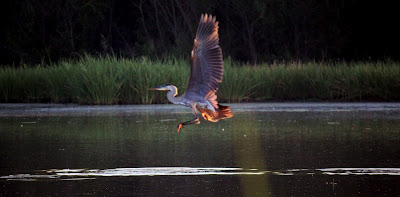 |
| North American River Otter in Great Trinity Forest Dallas Texas June 30, 2012 |
A rare sight indeed to see a River Otter inside the city limits of Dallas. Many fishermen, hunters and outdoorsmen can spend every weekend of their lives on the water in Texas and never see one. The matrix of ecology needed to support a River Otter limits sightings here. Just the right mix of food, wetlands and cover are needed to support an otter population. They feed on crawfish, fish, shellfish, frogs, snakes to name a few. All in abundance where we spotted this River Otter on the morning of June 30th.
I’m not sure how rare River Otters are in North Texas. As sighting of one is uncommon but how uncommon are they in population? An animal that spends so much time in the water is hard enough to spot. Compounded by the fact that it does not fly, have bright colors and favors hunting at dawn/dusk. TPWD says that their numbers are restricted to the eastern 1/3 of the state but sightings have been made as far as Wichita Falls and into West Texas.
Below is a video clip of the River Otter checking us out. I have found that the deeper in the woods you go, the less likely that an animal will bolt. Usually they sport a puzzled and interested look on their face. Just like the otter featured here.
 |
| Up close and personal with a River Otter |
I think I get more joy out of others seeing things like this than I do seeing it myself. Joining me were once again Bill Holston and someone I had not hiked with before David Mimlitch. David is best known for his great aerial photography of the Trinity River and this was his first hike downriver. I had met him on other occasions around the Calatrava bridge in Dallas but had not hiked with him on the river proper. If he had a blank checklist of things he wanted to see on our hike, I think he left with many things checked off. River otter, a whitetail deer jumped across the trail not 30 feet from us, green tree frogs, snakes, raptors, buntings and waterfowl species too numerous to mention. To catalog what we saw could fill a zoo.
In a jungle town Where the sun beats down To the rage of man and beast, The English garb Of the English sahib Merely gets a bit more creased. In Bangkok At twelve’o’clock They foam at the mouth and run, But mad dogs and Englishmen Go out in the midday sun. Noel Coward’s Mad Dogs and Englishmen(1930)
That old song sums it up. It got hot!
The day started on a much cooler and darker note…………………….
 |
| Venus and Jupiter aligned in the NE sky over the Great Trinity Forest before dawn June 30 |
The planetary alignment of Venus and Jupiter in the pre-dawn light was something to show up a little early for, 5:30am. Looking to the northeast the other planets were clearly visible just after nautical twilight. Starting this early is not so much a function of getting into the woods before the animals are up. This time of year the sultry steam of the summer sun makes a visit down there a tough go anytime between 10am-7pm. Finish before 10am or head down there after 7pm.
 |
| American Green Tree Frogs among the head high swamp grass in the Great Trinity Forest |
 |
| Great Blue Herons fishing in the early light of dawn |
 |
| Anhinga taking off from it’s perch |
Some of the wetland areas in the Great Trinity Forest offer long views where wildlife can be viewed at some distance. Other areas the views are short and restricted meaning you often spook birds off their roosts long before they can be seen. Such is the case with most of the Anhinga anhinga currently along the river and swamps. Fast to take flight and noisy to boot, they often spook other birds too. Spending most of the year in tropical rainforests and sub-tropical areas south of the border, Anhinga anhinga feel right at home in the oppressive heat of an early Texas summer.
 |
| Adult and Juvenile Wood Ducks |
 |
| White Faced Ibis |
Similar in appearance to the Glossy Ibis, the White-Faced Ibis can be identified by their red eyes, reddish legs and reddish feathers. In mating season, the White-Faced Ibis will develop a white ring around their face. The White-faced Ibis frequents marshes, swamps, ponds and rivers. Like other wading birds, they prefer small aquatic insects, fish, worms and frogs.
 |
| Great Blue Heron in the shallow swamp |
 |
| Widow Skimmer Dragonfly (Libellula luctuosa) |
 |
| Yellow Garden Spider (Argiope aurantia) |











